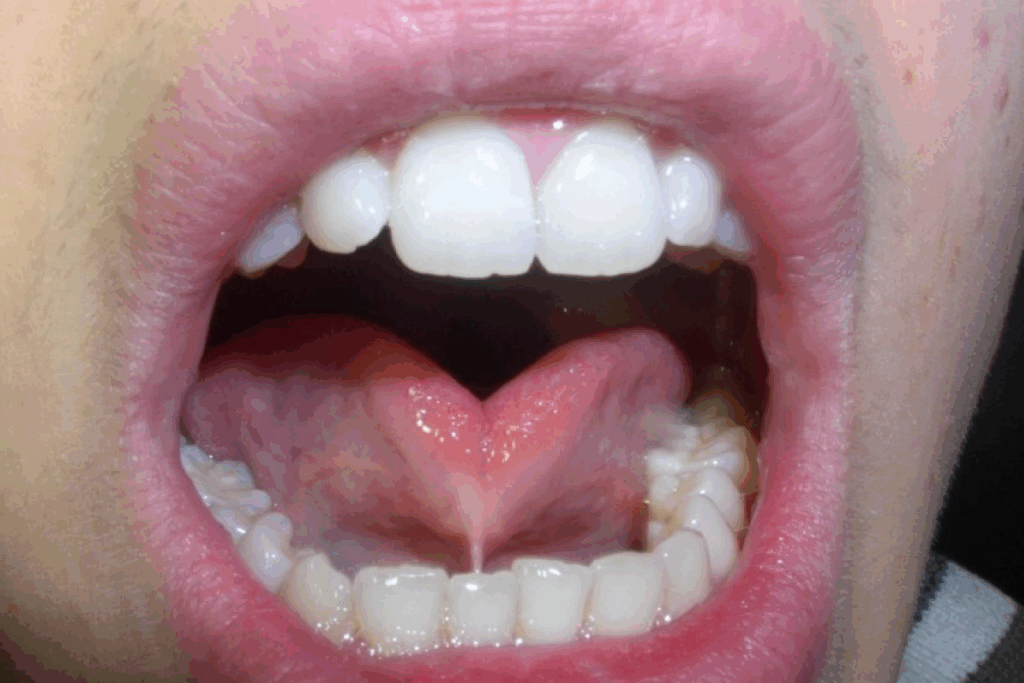Last Updated on October 31, 2025 by Saadet Demir

Viral vs bacterial pharyngitis: Learn the differentiating symptoms (e.g., cough, fever, tonsillar exudates) to guide diagnosis and treatment.
Pharyngitis is a common illness that affects the oropharynx mucous membranes. It’s often seen in primary care, making up about 6% of all visits.
Distinguishing between viral and bacterial causes is key. This is because their treatments are different. About 50 to 80 percent of sore throats are viral, needing only supportive care. But, missing bacterial infections like Group A streptococcal pharyngitis can lead to serious problems.
We will look into the differences between viral and bacterial pharyngitis. This guide aims to help readers understand how to diagnose and treat these conditions.

Pharyngitis is an inflammation of the oropharynx that affects people of all ages. We see it often in our work. It’s key to know its causes, how common it is, and how to manage it well.
Pharyngitis is when the oropharynx, the throat area behind the mouth, gets inflamed. Symptoms include a sore throat, trouble swallowing, and fever. It’s very common, hitting about 50 to 80 percent of people at some point.
About 5 to 15 percent of cases are caused by bacteria. Viruses are behind 50 to 80 percent. Knowing this helps us treat it better and avoid serious problems.
In the U.S., it’s a top reason for doctor visits, mainly among kids and young adults. Knowing how common and why it happens helps us make better treatment plans.
Many things can cause the oropharynx to get inflamed, but infections are the main reason. Viruses like rhinovirus, influenza, adenovirus, and coronaviruses are the top culprits. They can cause mild to severe symptoms and affect anyone.
Bacterial infections, like those from Group A beta-hemolytic Streptococcus (GABHS), also cause pharyngitis. GABHS needs quick antibiotic treatment to stop serious problems like rheumatic fever. Other bacteria can also cause it, but less often.
Knowing what causes oropharynx inflammation helps doctors treat pharyngitis better. We can choose the right treatment, like antiviral or antibiotic therapy, or just supportive care.

Acute pharyngitis happens when viruses or bacteria attack the throat. This attack triggers an immune response in the body. This response causes inflammation and symptoms.
When pathogens attack the throat, they damage the cells and start an inflammatory response. Chemicals like cytokines and chemokines are released. These chemicals bring immune cells to fight the infection.
The inflammatory process is key in fighting off the infection. But it also causes symptoms like pain and swelling.
The body’s immune response to throat infections is complex. It involves both the innate and adaptive immunity. Studies show that immune cells like neutrophils and lymphocytes are vital in fighting the infection.
“The immune response to pharyngeal infection involves the coordinated action of multiple cell types, leading to the production of inflammatory mediators and the elimination of pathogens.”
The immune response helps control the infection and prevent complications. But, an overactive response can cause tissue damage and worsen symptoms.
Immune Cell Type | Function in Pharyngeal Infection |
Neutrophils | Phagocytosis of pathogens |
Lymphocytes | Specific immune response and antibody production |
Macrophages | Clearance of pathogens and debris |
When the throat gets infected, it undergoes changes like inflammation and swelling. These changes cause symptoms like a sore throat and trouble swallowing.
The extent of tissue damage depends on the infection’s severity and the immune response. Knowing these changes helps in finding better treatments.
We must tell viral and bacterial pharyngitis apart to give the right care and avoid problems. Knowing the difference is key to treating it well.
Viral pharyngitis is more common, making up most cases. Most cases of pharyngitis are caused by viral infections, like rhinovirus and adenovirus. Bacterial pharyngitis, mainly from Group A beta-hemolytic Streptococcus (GABHS), is less common but important. Studies show viral pharyngitis can happen at any age. Bacterial pharyngitis, though, mostly affects kids and teens.
Viral and bacterial pathogens have different traits. Viral pathogens, like rhinovirus and coronavirus, spread easily and cause outbreaks. Bacterial pathogens, like GABHS, cause strep throat, needing quick antibiotic treatment to avoid serious issues.
Both viral and bacterial pharyngitis spread, but in different ways. Viral pharyngitis spreads through droplets, touching contaminated surfaces, and close contact. Bacterial pharyngitis, like strep throat, also spreads through close contact with someone who’s sick.
It’s important to know how they spread to stop them. Stopping both viral and bacterial pharyngitis needs good hygiene, like washing hands often and staying away from sick people.
It’s important to know what viruses cause pharyngitis to treat it right. Pharyngitis caused by viruses often comes with other cold symptoms. Finding out which virus is causing it is key.
Rhinovirus and adenovirus are top viruses that cause pharyngitis. Rhinovirus often leads to a cold, with a sore throat but no discharge. Adenovirus can cause mild throat pain or more serious illnesses like pharyngoconjunctival fever.
Both viruses spread easily through coughing and touching. Knowing the pharyngitis viral causes helps treat it better.
Epstein-Barr virus (EBV) is a big cause of pharyngitis in young adults. It leads to infectious mononucleosis, with a bad sore throat, fever, swollen lymph nodes, and tiredness. The throat pain from EBV can be hard to tell apart from bacterial infections.
EBV is diagnosed with blood tests. Knowing EBV’s role in viral pharyngitis etiology is important for the right treatment and avoiding antibiotics.
Influenza virus is known for causing respiratory infections, including pharyngitis. Influenza pharyngitis comes with fever, headache, and muscle pain. Other viruses like parainfluenza and coronavirus can also cause throat pain, but less often.
Knowing the pharyngitis viral causes helps doctors treat it better. While there are treatments for influenza, managing other viral pharyngitis is mostly supportive.
Bacterial pharyngitis, often caused by Group A Streptococcus, is a big challenge in healthcare. It’s key to tell it apart from viral pharyngitis. This helps in choosing the right treatment and avoiding serious problems.
Group A Beta-hemolytic Streptococcus (GABHS) is the top cause of bacterial pharyngitis. It needs antibiotics to stop serious issues like rheumatic fever and abscesses. Symptoms include swollen lymph nodes, tonsillar exudates, and sometimes a rash.
While GABHS is the main culprit, other bacteria like Arcanobacterium haemolyticum, Neisseria gonorrhoeae, and Mycoplasma pneumoniae can also cause it. They might show different symptoms and need different treatments.
Some factors make you more likely to get bacterial pharyngitis. These include being close to someone who’s sick, not washing your hands well, and being in crowded places. Knowing these risks helps in catching and treating the infection early.
It’s vital for doctors to understand the causes, symptoms, and risks of bacterial pharyngitis. Accurate diagnosis and treatment can prevent serious issues and improve health outcomes.
Understanding pharyngitis symptoms is key for correct diagnosis and treatment. Pharyngitis is inflammation of the pharynx. It shows different symptoms based on its cause. We’ll look at symptoms of viral and bacterial pharyngitis and the challenges in diagnosing them.
Viral pharyngitis often comes with symptoms of an upper respiratory infection. Common signs include:
These symptoms are often accompanied by malaise and mild fever. Cough and rhinorrhea help tell it apart from bacterial causes.
Bacterial pharyngitis, often caused by Group A beta-hemolytic Streptococcus (GABHS), has more severe symptoms. Signs include:
Severe throat pain and swollen tonsils suggest bacterial pharyngitis.
Despite clear signs, viral and bacterial pharyngitis symptoms often overlap. This makes diagnosing based on symptoms alone hard. A study found that while some symptoms were more common, there was a lot of variation.
Symptom | Viral Pharyngitis | Bacterial Pharyngitis |
Throat Pain | Mild to Moderate | Severe |
Cough | Common | Rare |
Rhinorrhea | Common | Rare |
Fever | Mild | High |
Tonsillar Exudates | Less Common | Common |
The table shows symptoms overlap. So, clinical scoring systems and lab tests are needed to tell them apart.
Diagnosing pharyngitis requires a mix of clinical checks and tests. It’s key to get it right because treating viral and bacterial infections is different.
Clinical scoring systems, like the Centor and McIsaac criteria, help figure out strep throat chances. They guide doctors on when to test more or start treatment.
The Centor criteria look at four signs: tonsillar exudates, sore lymph nodes, fever, and no cough. Each sign gets a point. The total score shows how likely a GAS infection is.
Centor Criteria | Score | Risk of GAS Infection |
0-1 | Low | <10% |
2-3 | Moderate | 20-40% |
4 | High | 50-60% |
Lab tests are vital for confirming bacterial pharyngitis. The rapid strep test is a fast way to get results.
We use different lab tests, including:
These tests help tell if it’s a viral or bacterial infection. This guides the right treatment.
In tough cases of pharyngitis, like peritonsillar abscess or deep neck infections, we might need imaging. CT scans or ultrasound are often used.
These images help us see how big the infection is. They guide how to manage it further.
By using clinical checks, scoring systems, lab tests, and imaging when needed, we can accurately diagnose and treat pharyngitis.
It’s important to know about complications and treatments for pharyngitis. This condition, which affects the pharynx, can come from viruses or bacteria. Each type needs a different treatment plan.
Untreated bacterial pharyngitis can lead to serious issues. Rheumatic fever and glomerulonephritis are two major risks. Rheumatic fever can damage heart valves, and glomerulonephritis can harm the kidneys.
Viral pharyngitis usually gets better on its own. But, bacterial pharyngitis needs antibiotics to avoid serious problems.
Viral pharyngitis is treated with symptom relief. Rest, staying hydrated, and pain relievers help. Sometimes, antiviral drugs are used for specific viruses.
Bacterial pharyngitis gets treated with antibiotic therapy. Penicillin or amoxicillin are usually the first choice. It’s key to finish all antibiotics to avoid complications. For penicillin allergies, other antibiotics like azithromycin or clarithromycin are options.
Many remedies can help with pharyngitis symptoms. Throat lozenges, warm salt water gargles, and humidifiers can soothe the throat. Pain relievers like acetaminophen or ibuprofen can also help. Drinking plenty of water and resting are important for recovery.
Knowing how to treat and manage pharyngitis helps healthcare providers. They can then give better care and advice. This reduces the risk of serious problems and helps patients get better faster.
Knowing the difference between viral and bacterial pharyngitis is key. We’ve talked about the causes, symptoms, and how to diagnose them. This shows why getting the right diagnosis and treatment is so important.
Preventing pharyngitis is also vital. Simple steps like washing your hands often, staying away from sick people, and keeping clean can help a lot. These actions can stop pharyngitis from spreading and ease the load on hospitals.
The outlook for both viral and bacterial pharyngitis is good with the right care. Antibiotics work well for bacterial cases, and there are ways to ease symptoms in both. By understanding how to prevent and treat pharyngitis, we can help patients get better faster.
Pharyngitis is when the oropharynx gets inflamed. It’s often caused by viruses or bacteria. Knowing the cause helps decide how to treat it.
Viral pharyngitis is more common. It can be caused by many viruses. Bacterial pharyngitis, often caused by Group A Streptococcus, has its own patterns.
Viral pharyngitis has mild symptoms like a sore throat and cough. Bacterial pharyngitis has severe symptoms, like a high fever and swollen lymph nodes.
Doctors use clinical evaluation and scoring systems like Centor and McIsaac. They also do throat cultures and rapid antigen tests. Imaging is used in complex cases.
Untreated bacterial pharyngitis can cause serious problems. These include rheumatic fever, kidney inflammation, and abscesses. This shows why quick treatment is key.
Viral pharyngitis is treated with symptom relief. Bacterial pharyngitis needs antibiotics to prevent serious issues and shorten symptoms.
Common viruses include rhinovirus, adenovirus, Epstein-Barr virus, and influenza virus. Each has its own signs and symptoms.
Yes, prevention is possible. Good hygiene, like washing hands often, and avoiding sick people help. Staying home when sick also reduces spread.
With the right treatment, most people recover from both viral and bacterial pharyngitis in a week or two.
It’s about looking at symptoms, test results, and how you respond to treatment. This helps decide how to manage it.
Antibiotics are critical for bacterial pharyngitis, like Group A Streptococcus. They prevent serious problems and shorten symptoms.
Yes, measures like pain relief, staying hydrated, and resting help with symptoms in both types of pharyngitis.
National Center for Biotechnology Information. (2025). Viral vs Bacterial Pharyngitis How Do You Tell. Retrieved from https://www.ncbi.nlm.nih.gov/books/NBK559007/
Subscribe to our e-newsletter to stay informed about the latest innovations in the world of health and exclusive offers!
WhatsApp us